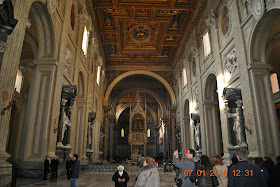Photography is a great chance for sharing the beauty of art and keeping the travelling memories alive. Travelling and photography are two passions which perfectly combine in the architect's mission to build up a broad knowledge and understanding of the world. Today's article presents a collection of architectural photographs taken by me while visiting Rome in January 2014, using Nikon D3000 and iPhone 5 camera.
Undoubtedly, Rome is the perfect holiday destination for architecture and art lovers. With a wide range of the world's most famous artworks, and magnificent samples of classical architecture, the capital of Italy perfectly combines its visually-depicted history with the modern lifestyle of the locals.
Since the Ancient times, the Roman architecture has gone through numerous stages, all imprinted with the refinement of the classical spirit. The Roman forum offers its visitors an insight into the glorious imperial Rome. The architecture of the Byzantine churches was inspired by the Roman basilica. Even though Romanesque and Gothic architecture are also present within the history of Roman architecture, it is the Rennaisance and Baroque styles that make Rome truly stand out. Rome is generally regarded as the second Rennaisance capital of Italy after Florence, while it is also considered as the epicentre of Baroque architecture.
The cathedral of the Diocese of Rome and the first among the major basilicas of Rome, San Giovanni in Laterano is dedicated to St. John the Baptist and St. John the Evanghelist. Built by emperor Constantine the Great in the 4th century, the basilica was consecrated in 324 A.D. In 1650, major restoration work was carried out by Francesco Borromini for Pope Innocent X, resulting the Baroque style of the interior which can be admired today. The late Baroque facade was completed by Alessandro Galilei in 1735. The Cosmatesque pavement and the graceful baldacchino over the high altar date back to the 14th century.
The Colosseum
Built of concrete and stone between 70 and 80 A.D., Colosseum is the symbol of Rome and one of the greatest architectural achievements of the Ancient times. It is the largest amphitheatre in the world, with a capacity of 50,000 - 80,000 spectators.
St. Peter's basilica
In front of the basilica there is St. Peter's square, surrounded by the colonnade of Bernini.
The national monument dedicated to king Vittorio Emanuelle II was designed by Giuseppe Sacconi in 1885. The massive eclectic building which offers a magnificent view at night, was highly controversial, as it is not representative for Roman architecture, being inspired, instead, by Greek and Teutonic styles.
Piazza Navona
A magnificent sample of Baroque architecture, Piazza Navona has, among its attraction, Bernini's Fountain of the Four Rivers and the church of Sant'Agnese in Agone, designed by Francesco Borromini.
Commissioned by Marcus Agrippa during the reign of Augustus (27 B.C. - 14 A.D.), the Pantheon was rebuilt around 126 A.D. by the emperor Hadrian. It features the world's largest unreinforced concrete dome, under which a 43.3 m diametre sphere fits in. The interior is reach in geometrical decorations, circles and squares unifying the design.
Fontana di Trevi
Designed by the Italian architect Nicola Savi, it is the largest Baroque fountain in Rome and one of the most famous fountains in the world. There is a tradition related to the Trevi fountain: if the visitors throw a coin in the fountain with the right hand over the left shoulder, it is said that, one day, they will come back to Rome.
It was designed by the architect Carlo Maderno in the Baroque style. Built between 1605-1620, the church houses Gian Lorenzo Bernini's masterpiece, the Ecstasy of Saint Theresa.
The Church of St. Ignatius of Loyola
It was built in Baroque style between 1626 and 1650 and consecrated in 1722. The design of the church belongs to the Jesuit architect Orazio Grassi and it boasts a trompe l'oeil ceiling fresco by Andrea Pozzo, depincting the Apotheosis of Saint Ignatius.
































No comments:
Post a Comment